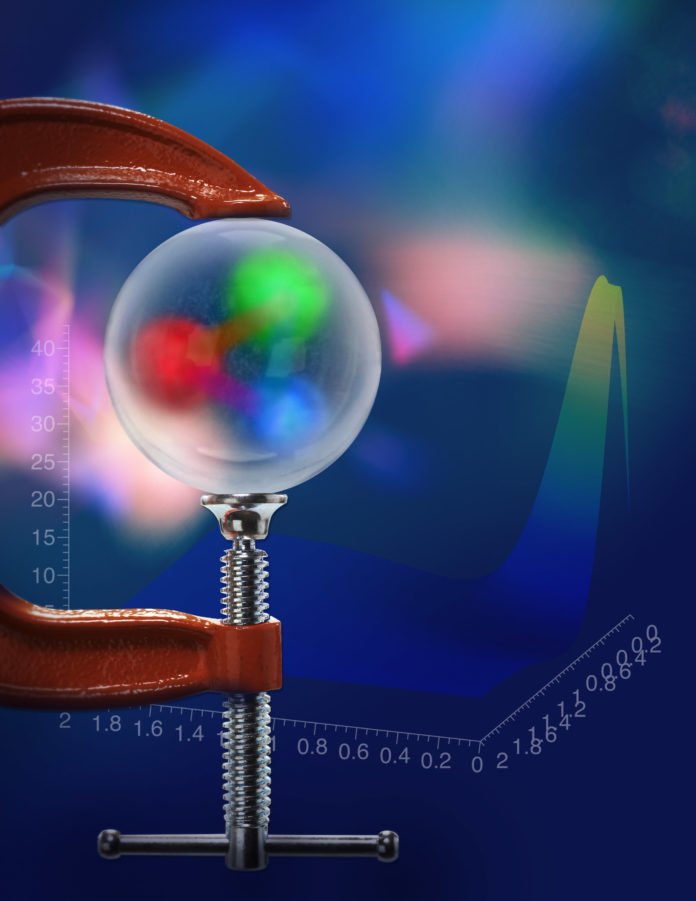Inside every atom in the Universe, the proton composed of pressure cooker like condition that outperforms the atom-crushing heart of a neutron star. Scientists at the Department of Energy’s Thomas Jefferson National Accelerator Facility conducted a study where they quantified the pressure inside the proton.
Scientists found that the proton’s building blocks, the quarks, are subjected to a pressure of 100 decillions Pascal (1035) near the center of a proton. The pressure is about 10 times greater than the pressure in the heart of a neutron star.
Once thought impossible to obtain, this measurement is the result of a clever pairing of two theoretical frameworks with existing data.
First, there are the generalized parton distributions. GPDs allow researchers to produce a 3D image of the proton’s structure as probed by the electromagnetic force. The second is the gravitational form factors of the proton. These form factors describe what the mechanical structure of the proton would be if researchers could probe the proton via the gravitational force.
Volker Burkert, Jefferson Lab Hall B Leader said, “We found an extremely high outward-directed pressure from the center of the proton and a much lower and more extended inward-directed pressure near the proton’s periphery.”
“The distribution of pressure inside the proton is dictated by the strong force, the force that binds three quarks together to make a proton.”
“Our results also shed light on the distribution of the strong force inside the proton. We are providing a way of visualizing the magnitude and distribution of the strong force inside the proton. This opens up an entirely new direction in nuclear and particle physics that can be explored in the future.”
The theorist who developed the concept of gravitational form factors in 1966, Heinz Pagels, famously observed in the paper detailing them that there was “very little hope of learning anything about the detailed mechanical structure of a particle, because of the extreme weakness of the gravitational interaction.”
Recent hypothetical work, be that as it may, has associated GPDs to the gravitational frame factors, permitting the outcomes from electromagnetic tests of protons to substitute for gravitational tests.
The electromagnetic test comprises of light emissions created by the Continuous Electron Beam Accelerator Facility, a DOE Office of Science User Facility. These electrons are coordinated into the cores of particles, where they collaborate electromagnetically with the quarks inside protons through a procedure called profoundly virtual Compton diffusing.
In the DVCS procedure, an electron enters a proton and trades a virtual photon with a quark, exchanging vitality to the quark and proton. A brief timeframe later, the proton discharges this vitality by emanating another photon and proceeds on in place.
This procedure is practically equivalent to the computations Pagels performed for how it is conceivable to test the proton gravitationally by means of a theoretical light emission. The Jefferson Lab analysts could abuse a similitude between the outstanding electromagnetic and theoretical gravitational examinations to get their outcome.
Francois-Xavier Girod, a Jefferson Lab staff scientist and co-author on the paper said, “There’s a photon coming in and a photon coming out. And the pair of photons both is spin-1. That gives us the same information as exchanging one graviton particle with spin-2. So now, one can basically do the same thing that we have done in electromagnetic processes — but relative to the gravitational form factors, which represent the mechanical structure of the proton.”
Scientists are further planning to apply the system too much more exact information that will be accessible soon to decrease the vulnerabilities in the present investigation and start progressing in the direction of uncovering other mechanical properties of the omnipresent proton, for example, the interior shear powers and the proton’s mechanical range.
The result was recently published in the journal Nature.
